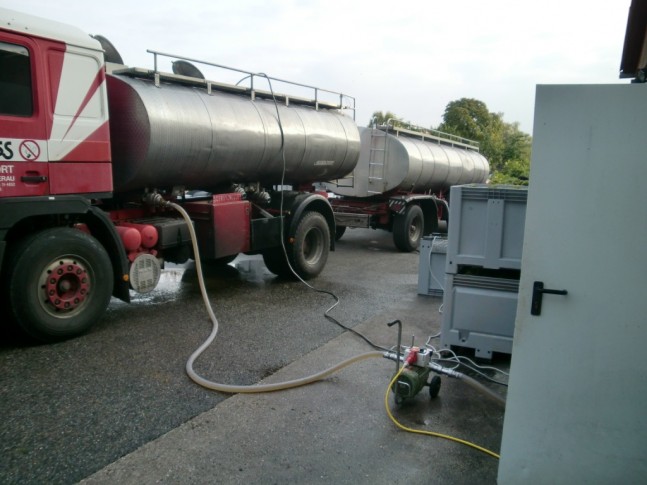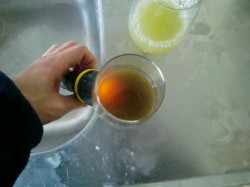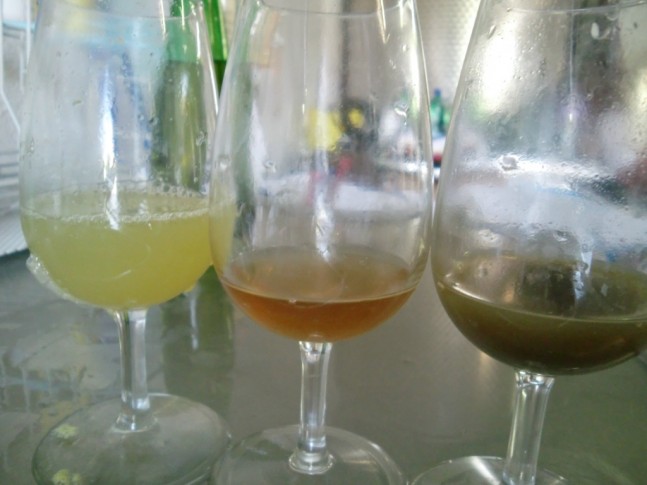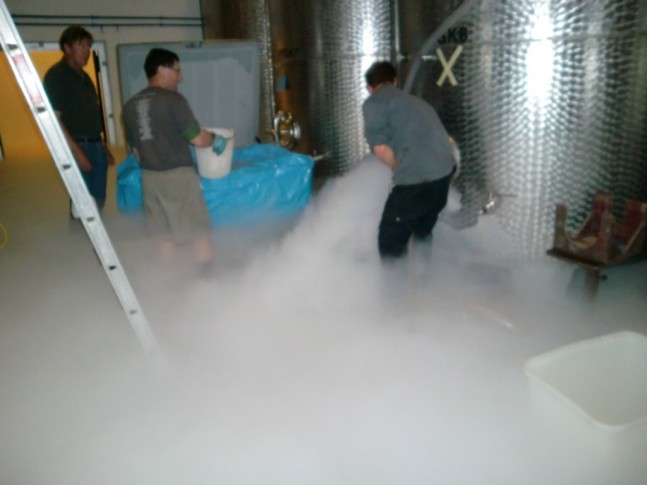Day Eleven: Dry Ice Wonderland 06/10/2011
It was a very busy day. Early in the morning, a tanker filled with grape must rolled up at our doorsteps. The grape must has been bought to be used for the supermarket wines under another label. This wine will be sold in the UK and Poland. The must taste considerably of lesser quality in terms of flavour compared to the ones Dr. Bert brought in from his vineyards.

Salomon Winery tanker arrives full of juice
The transfer from the tanker into the tanks took a while as the initially leesy juice was first pumped out into a tank. We had to stand by to see when the juice started becoming clear and we quickly transferred this clear juice to another than. Finally the lees will start to appear again and we had to transfer those to a third tank and merge it with the first tank with the initial lees. I suppose the lees are being sucked out first form the bottom and as it does so some of the lees get disturbed and go to the top, which is why they appear again.
I did my usual rounds of measuring alcohol levels, taking temperature readings and checking if the ferments were stinky. At the same time, I tasted some of the fermenting must. I realized that Riesling must before ferment had an uncanny resemblance to Polka green tea from a can. Tank GK 3 filled with Gruner was bubbling like crazy because of the ferment. I was told that adding a dash of olive oil actually stops the foam from erupting out of the top of the tank because it changes the surface tension of the liquid on the top. We didn’t do this but transferred some of the contents out. I wonder if that is why some of my wines smell of olives.

Salomon Winery - pressing juice day, not so bright lees
I was told that there was going to be more picking going on over the next 9 days but the reserve has yet to come. I tasted some of the grapes grown on the loess soil and compared them to those higher up the terrace. They were less ripe and flavourful although they had higher acid levels in them. It seems that the grapes grown higher up the terrace are on a different soil which is on bedrock of granite. This could explain some of the heat-retention properties of the soil and the riper levels in those grapes.
Dr. Bert had the harvest team pour out the contents from some heat damaged bottles of pfeffenberg and kögl 2003. He said that some of the wines were stored in a warehouse where refrigeration broke down at was in conditions of 35 degrees Celsius for months. He was planning on adding the damaged wines to a tank of fermenting must with lees that would have fermented 40% of its sugars.
I learned that wines can actually freshen up on the nose and palate when fermented with lees. This is interesting as I know that lees can create reduction in wine when it starts to digest itself. It seems that heat damage cause oxidation and perhaps the lees will take in some of the oxygen. Also, lees can impart a fresh flavor to wine.
The 2003 bottles will be declassified into something else. I tasted both heat damaged labels. I couldn’t find anything much wrong with the kögl but the pfeffenberg was little strange. It had lots of petrol and kerosene characters on it which is typical for a 2003 Riesling, especially in Australia. It is not very common for an Austrian wine to be so dominant in these characters even after long aging. Also, the palate was heavy and had a rubbery taste in it. It had a lot of fuel oil flavours and hard acid. The finish was extremely toasty and nutty. It had a little sherry-element to it.
At the same time, newly picked grapes were being pressed. I collected some of the free run juice and tasted them side by side with the leesy juice and the clear juice. Please note that the free run juice is basically what comes out of the pressure before any pressure is added to the grapes. The leesy juice and clear juice are from grapes have both already been pressed and left to settle overnight.
The leesy juice was murkier and darker in colour compared to the clear juice. The nose of the leesy juice was leesy (It is hard to describe leesy. Maybe, think of sometime like bread yeast or mud) which the clear juice had a fruit purity in it, with apple flavor. The texture of the leesy juice was coarser and had more mouth feel than the clear juice while the clear juice has a rounder texture. Comparing them to free-run juice, free-run juice was cleaner than the leesy juice, but was more clean and had more apparent sweetness and acidity compared to the pressed juice. I suppose the reason why the free-run juice is sweeter is because pressed juice has less acid in it.

From Left to Right - freerun - clear juice - juice with lees
Some of the juice that came in was warm but we didn’t have tanks with good enough refrigeration to chill the must down for ferment. Some of the tanks used water to chill the ferments down and Dr.Bert didn’t want to add glycerol in the water pockets of the tank to bring the temperature of the must down quicker. He was concerned that the glycerol would seep into the steel plates underneath the water pockets which would contaminate the wine. So he ordered a huge chunk of dry ice.
It was an awesome experience to put dry ice in the tanks. Smoke was just coming out of the tanks and it was as if we just died and went to wine heaven. It was a wonderful sight to see. In all seriousness, we could possibly die doing this if the cellars were not well-ventilated because we could die from asphyxiation from the huge amount of carbon dioxide released. We had to be very careful as usually people can die when they try to help someone who has already collapsed from shortage of oxygen. Carbon dioxide is heavier than oxygen

|
|
Tweet |






2 Comments to Sommelier Shalom Chin Austria Vintage Blog – Day 11 | Comments Feed
That’s more than seinsble! That’s a great post!
Very valid, pithy, sucicnct, and on point. WD.
The comments are closed.